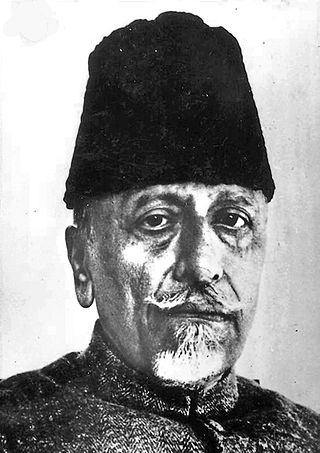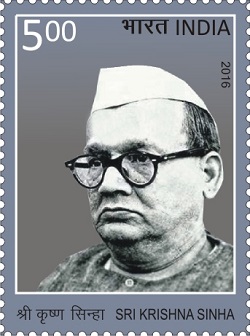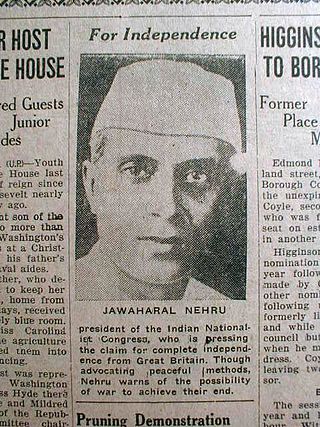
The Indian independence movement was a series of historic events in South Asia with the ultimate aim of ending British colonial rule. It lasted until 1947, when the Indian Independence Act 1947 was passed.

Mahadev Haribhai Desai was an Indian independence activist, scholar and writer best remembered as Mahatma Gandhi's personal secretary. He has variously been described as "Gandhi's Boswell, a Plato to Gandhi's Socrates, as well as an Ānanda to Gandhi's Buddha".

Abul Kalam Ghulam Muhiyuddin Ahmed bin Khairuddin Al-Hussaini Azad ; 11 November 1888 – 22 February 1958) was an Indian independence activist, writer and a senior leader of the Indian National Congress. Following India's independence, he became the First Minister of Education in the Indian government. He is commonly remembered as Maulana Azad; the word Maulana is an honorific meaning 'Our Master' and he had adopted Azad (Free) as his pen name. His contribution to establishing the education foundation in India is recognised by celebrating his birthday as National Education Day across India.

The Salt march, also known as the Salt Satyagraha, Dandi March, and the Dandi Satyagraha, was an act of nonviolent civil disobedience in colonial India, led by Mahatma Gandhi. The 24-day march lasted from 12 March 1930 to 6 April 1930 as a direct action campaign of tax resistance and nonviolent protest against the British salt monopoly. Another reason for this march was that the Civil Disobedience Movement needed a strong inauguration that would inspire more people to follow Gandhi's example. Gandhi started this march with 78 of his trusted volunteers. The march spanned 387 kilometres (240 mi), from Sabarmati Ashram to Dandi, which was called Navsari at that time. Growing numbers of Indians joined them along the way. When Gandhi broke the British Raj salt laws at 8:30 am on 6 April 1930, it sparked large-scale acts of civil disobedience against the salt laws by millions of Indians.

Motilal Nehru was an Indian lawyer, activist, and politician affiliated with the Indian National Congress. He served as the Congress President twice, from 1919 to 1920 and from 1928 to 1929. He was a patriarch of the Nehru-Gandhi family and the father of Jawaharlal Nehru, India's first Prime Minister.
Events in the year 1930 in India.

Sir Tej Bahadur Sapru was an Indian freedom fighter, lawyer, and politician. He was a key figure in India's struggle for independence, helping draft the Indian Constitution. He was the leader of the Liberal party in British-ruled India.
The Indian Statutory Commission, also known as the Simon Commission, was a group of seven members of the British Parliament under the chairmanship of Sir John Simon. The commission arrived in the Indian subcontinent in 1928 to study constitutional reform in British India. One of its members was Clement Attlee, who would later become the Prime Minister of the United Kingdom.
The three Round Table Conferences of 1930–1932 were a series of peace conferences, organized by the British Government and Indian political personalities to discuss constitutional reforms in India. These started in November 1930 and ended in December 1932. They were conducted as per the recommendation of Muhammad Ali Jinnah to Viceroy Lord Irwin and Prime Minister Ramsay MacDonald, and by the report submitted by the Simon Commission in May 1930. Demands for Swaraj or self-rule in India had been growing increasingly strong. B. R. Ambedkar, Jinnah, Sir Tej Bahadur Sapru, V. S. Srinivasa Sastri, Sir Muhammad Zafrulla Khan, K. T. Paul and Mirabehn were key participants from India. By the 1930s, many British politicians believed that India needed to move towards dominion status. However, there were significant disagreements between the Indian and the British political parties that the Conferences would not resolve. The key topic was about constitution and India which was mainly discussed in that conference. There were three Round Table Conferences from 1930 to 1932.

The Gandhi–Irwin Pact was a political agreement signed by Mahatma Gandhi and Lord Irwin, Viceroy of India, on 4 March 1931 before the Second Round Table Conference in London. Before this, Irwin, the Viceroy, had announced in October 1929 a vague offer of 'dominion status' for India in an unspecified future and a Round Table Conference to discuss a future constitution. The Second Round Table Conference was held from September to December 1931 in London. This movement marked the end of the Civil Disobedience Movement in India.
The Swaraj Party, established as the Congress-Khilafat Swaraj Party, was a political party formed in India on 1 January 1923 after the Gaya annual conference in December 1922.
The Nehru Report of 1928 was a memorandum by All Parties Conference in British India to appeal for a new dominion status and a federal set-up of government for the constitution of India. It also proposed for the Joint Electorates with reservation of seats for minorities in the legislatures.

Shri Krishna Singh (Sinha) (21 October 1887 – 31 January 1961), also known as Shri Babu, was the first chief minister of the Indian state of Bihar (1946–61). Except for the period of World War II, Sinha was the chief minister of Bihar from the time of the first Congress Ministry in 1937 until his death in 1961. He led the Dalit entry into the Vaidyanath Temple, Deoghar. He was the first chief minister in the country to abolish the zamindari system. He was imprisoned for a total of about eight years in British India. He held mass meetings at which he spoke. He was known as Bihar Kesari for his "lionlike roars" in public speaking.
Hindustan Socialist Republican Association (HSRA), previously known as the Hindustan Republican Army and Hindustan Republican Association (HRA), was a radical left-wing Indian revolutionary organization, founded by Sachindranath Sanyal. After changes in Bhagat Singh's ideology and the influence of the Russian Revolution, they held meetings in Feroz Shah Kotla Maidan and added the word socialist to their name. Ram Prasad Bismil, Ashfaqulla Khan, Sachindra Nath Bakshi, Sachindranath Sanyal and Jogesh Chandra Chatterjee were the leaders of the group at the time. HSRA's manifesto titled The Revolutionary and written constitution were produced as evidence in the Kakori conspiracy case of 1925.

The Declaration of Purna Swaraj was a resolution which was passed in 1930 because of the dissatisfaction among the Indian masses regarding the British offer of Dominion status to India. The word Purna Swaraj was derived from Sanskrit पूर्ण (Pūrṇa) 'Complete' and स्वराज (Svarāja) 'Self-rule or Sovereignty', or Declaration of the Independence of India, it was promulgated by the Indian National Congress, resolving the Congress and Indian nationalists to fight for Purna Swaraj, or complete self-rule/total independence from the British rule.

After the Indian Rebellion of 1857, the British Government took over the administration to establish the British Raj. The British Raj was the period of British Parliament rule on the Indian subcontinent between 1858 and 1947, for around 89 years of British occupation. The system of governance was instituted in 1858 when the rule of the East India Company was transferred to the Crown in the person of Queen Victoria.
Sir Harry Graham Haig KCSI CIE JP ICS was a British administrator in India.

Syed Mahmud (1889–1971) was an Indian politician and senior leader in the Indian National Congress during the Indian independence movement and in post-independence India.
The August Offer was an offer made by Viceroy Lord Linlithgow in 1940 promising the expansion of the Viceroy's Executive Council to include more Indians, the establishment of an advisory war council, the giving of full weight to minority opinion, and the recognition of the Indians' right to frame their own constitution after the end of the war. In return, it was hoped that all parties and communities in India would co-operate in Britain's efforts during the Second World War. However, the proposal was rejected by the Indian National Congress.
The Women's suffrage movement in India fought for Indian women's enfranchisement in Colonial India under British rule. Beyond suffrage, the movement was fighting for women's right to stand for and hold office during the colonial era. In 1918, when Britain granted limited suffrage to women property holders, the law did not apply to British citizens in other parts of the Empire. Despite petitions presented by women and men to the British commissions sent to evaluate Indian voting regulations, women's demands were ignored in the Montagu–Chelmsford Reforms. In 1919, impassioned pleas and reports indicating support for women to have the vote were presented by suffragists to the India Office and before the Joint Select Committee of the House of Lords and Commons, who were meeting to finalize the electoral regulation reforms of the Southborough Franchise Committee. Though they were not granted voting rights, nor the right to stand in elections, the Government of India Act 1919 allowed Provincial Councils to determine if women could vote, provided they met stringent property, income, or educational levels.









